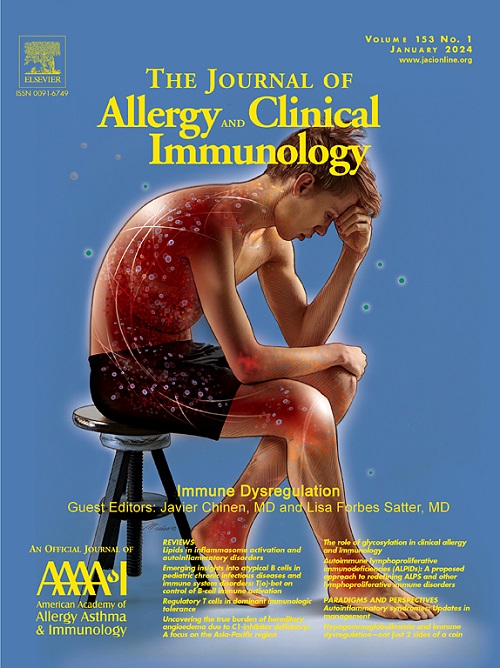Transcriptomic profiling of chronic hand eczema skin reveals shared immune pathways and molecular drivers across subtypes
IF 11.4
1区 医学
Q1 ALLERGY
引用次数: 0
Abstract
Background
Chronic hand eczema (CHE) is a common skin disease with different subtypes, but knowledge of the molecular patterns associated with each subtype is limited.
Objective
We sought to characterize the CHE transcriptome across subtypes.
Methods
Using RNA sequencing, we studied the transcriptome of 220 full-thickness skin biopsy samples collected from palms, dorsa, and arms from 96 patients with CHE and/or atopic dermatitis (AD) and 32 healthy controls. The primary analysis focused on 16 healthy and 54 lesional CHE palm samples that were further stratified by AD status and unique etiology. Differentially expressed genes (DEGs) were identified across the cohort, and Ingenuity Pathway Analysis (IPA) was used for pathway analysis and upstream regulator prediction.
Results
We identified anatomic site-specific transcriptomic variations, showing unique characteristics in both healthy and CHE-affected palm skin. In CHE palms, we identified 2333 DEGs versus healthy palms. Upregulated genes predominantly involved keratinocyte host inflammation and immune signaling, while downregulated genes were linked to lipid metabolism and epidermal barrier function. IPA revealed numerous activated proinflammatory pathways, dominated by TH1 and TH2. Key upstream regulators included type 1 (IFN-γ, TNF, STAT1, IL-2) and type 2 (IL-4) associated molecules, and IL-1β. Lesional palm signatures were broadly shared across CHE subtypes. No DEGs were found between allergic and irritant contact dermatitis CHE. Subtype-specific pathway and upstream regulator activity variations were noted.
Conclusion
The lesional CHE transcriptome is primarily shared among subtypes and is characterized by activation of several immune pathways, dominated by TH1 and TH2. Key shared upstream regulators were identified, highlighting potential universal therapeutic targets.
慢性手湿疹皮肤的转录组学分析揭示了不同亚型共享的免疫途径和分子驱动因素。
背景:慢性手湿疹(CHE)是一种常见的皮肤病,具有不同的亚型,但对每种亚型相关的分子模式的了解有限。目的:表征CHE亚型的转录组特征。方法:采用rna测序技术,研究了96例CHE和/或特应性皮炎(AD)患者和32名健康对照者的手掌、背部和手臂的220份全层皮肤活检组织的转录组。主要分析集中在16个健康手掌样本和54个病变手掌样本,这些样本根据AD状态和独特病因进一步分层。在整个队列中鉴定了差异表达基因(DEGs),并使用独创性途径分析(IPA)进行途径分析和上游调节因子预测。结果:我们确定了解剖位点特异性转录组变异,在健康和受che影响的手掌皮肤中显示出独特的特征。在CHE手掌中,与健康手掌相比,我们发现了2333个deg。上调的基因主要涉及角化细胞宿主炎症和免疫信号,而下调的基因与脂质代谢和表皮屏障功能有关。IPA揭示了以Th1和Th2为主的多种激活的促炎通路。关键的上游调节因子包括1型(IFNG、TNF、STAT1、IL-2)和2型(IL-4)相关分子,以及IL-1β。病变手掌特征在CHE亚型中广泛共享。在过敏性和刺激性接触性皮炎CHE之间没有发现deg。注意到亚型特异性途径和上游调节剂活性的变化。结论:病变CHE转录组主要在亚型之间共享,其特征是激活几种免疫途径,以Th1和Th2为主。确定了关键的共享上游调节因子,突出了潜在的通用治疗靶点。
本文章由计算机程序翻译,如有差异,请以英文原文为准。
求助全文
约1分钟内获得全文
求助全文
来源期刊
CiteScore
25.90
自引率
7.70%
发文量
1302
审稿时长
38 days
期刊介绍:
The Journal of Allergy and Clinical Immunology is a prestigious publication that features groundbreaking research in the fields of Allergy, Asthma, and Immunology. This influential journal publishes high-impact research papers that explore various topics, including asthma, food allergy, allergic rhinitis, atopic dermatitis, primary immune deficiencies, occupational and environmental allergy, and other allergic and immunologic diseases. The articles not only report on clinical trials and mechanistic studies but also provide insights into novel therapies, underlying mechanisms, and important discoveries that contribute to our understanding of these diseases. By sharing this valuable information, the journal aims to enhance the diagnosis and management of patients in the future.

 求助内容:
求助内容: 应助结果提醒方式:
应助结果提醒方式:


